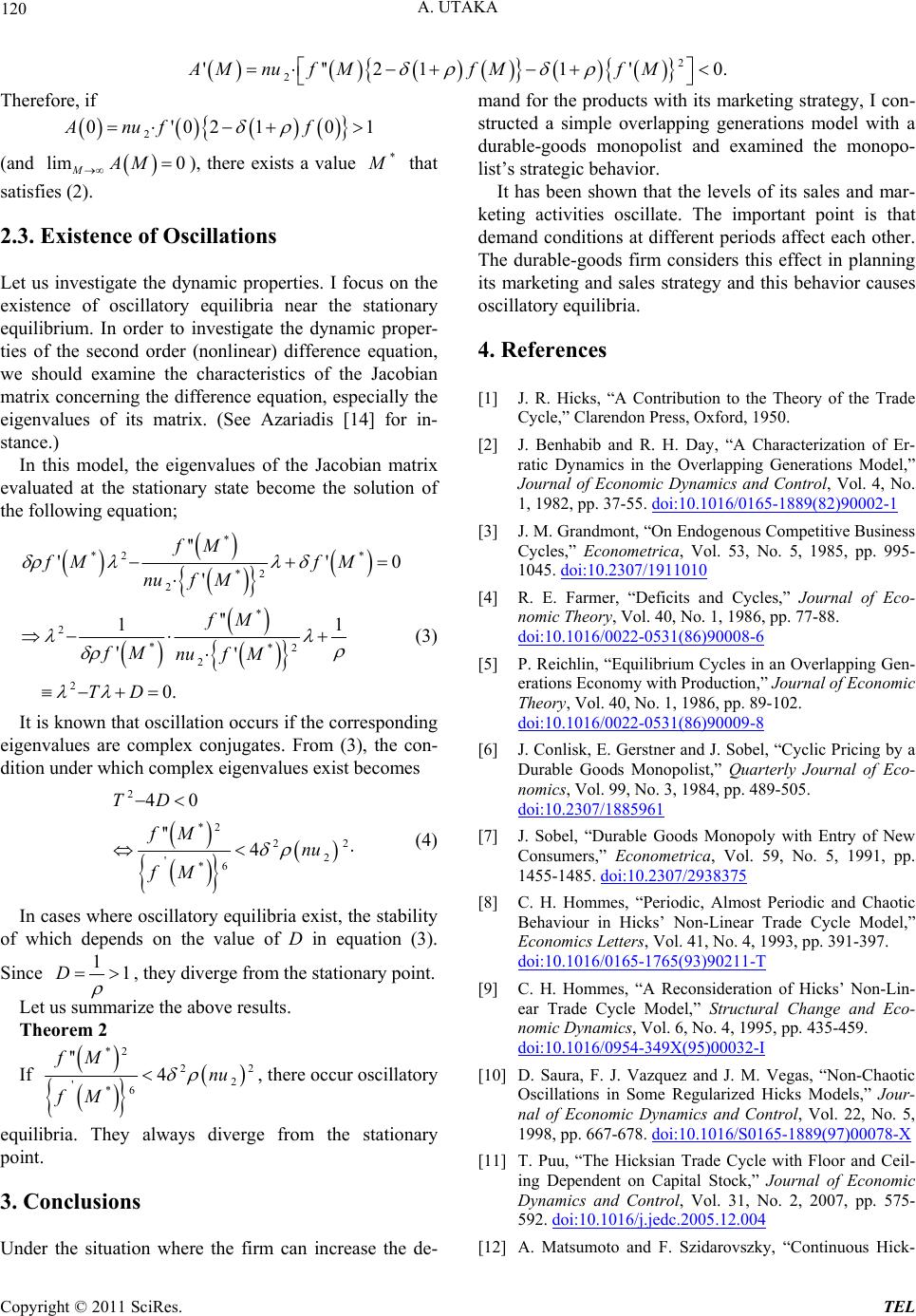
A. UTAKA
120
2
2
'''21 1'AMnufMfMf M
0.
1
Therefore, if
2
0'0210Anuf f
(and ), there exists a value
lim 0
MAM
*
that
satisfies (2).
2.3. Existence of Oscillations
Let us investigate the dynamic properties. I focus on the
existence of oscillatory equilibria near the stationary
equilibrium. In order to investigate the dynamic proper-
ties of the second order (nonlinear) difference equation,
we should examine the characteristics of the Jacobian
matrix concerning the difference equation, especially the
eigenvalues of its matrix. (See Azariadis [14] for in-
stance.)
In this model, the eigenvalues of the Jacobian matrix
evaluated at the stationary state become the solution of
the following equation;
*
*2 *
*2
2
*
2
**2
2
2
''
'
'
''
1
''
0.
fM
fM fM
nuf M
fM
fM nuf M
TD
'
0
1
(3)
It is known that oscillation occurs if the corresponding
eigenvalues are complex conjugates. From (3), the con-
dition under which complex eigenvalues exist becomes
2
*2
2
2
'*6
40
'' 4
TD
fM nu
fM
2
(4)
In cases where oscillatory equilibria exist, the stability
of which depends on the value of D in equation (3).
Since 11D
, they diverge from the stationary point.
Let us summarize the above results.
Theorem 2
If
*2
2
2
'*6
'' 4
fM nu
fM
2
, there occur oscillatory
equilibria. They always diverge from the stationary
point.
3. Conclusions
Under the situation where the firm can increase the de-
mand for the products with its marketing strategy, I con-
structed a simple overlapping generations model with a
durable-goods monopolist and examined the monopo-
list’s strategic behavior.
It has been shown that the levels of its sales and mar-
keting activities oscillate. The important point is that
demand conditions at different periods affect each other.
The durable-goods firm considers this effect in planning
its marketing and sales strategy and this behavior causes
oscillatory equilibria.
4. References
[1] J. R. Hicks, “A Contribution to the Theory of the Trade
Cycle,” Clarendon Press, Oxford, 1950.
[2] J. Benhabib and R. H. Day, “A Characterization of Er-
ratic Dynamics in the Overlapping Generations Model,”
Journal of Economic Dynamics and Control, Vol. 4, No.
1, 1982, pp. 37-55. doi:10.1016/0165-1889(82)90002-1
[3] J. M. Grandmont, “On Endogenous Competitive Business
Cycles,” Econometrica, Vol. 53, No. 5, 1985, pp. 995-
1045. doi:10.2307/1911010
[4] R. E. Farmer, “Deficits and Cycles,” Journal of Eco-
nomic Theory, Vol. 40, No. 1, 1986, pp. 77-88.
doi:10.1016/0022-0531(86)90008-6
[5] P. Reichlin, “Equilibrium Cycles in an Overlapping Gen-
erations Economy with Production,” Journal of Economic
Theory, Vol. 40, No. 1, 1986, pp. 89-102.
doi:10.1016/0022-0531(86)90009-8
[6] J. Conlisk, E. Gerstner and J. Sobel, “Cyclic Pricing by a
Durable Goods Monopolist,” Quarterly Journal of Eco-
nomics, Vol. 99, No. 3, 1984, pp. 489-505.
doi:10.2307/1885961
[7] J. Sobel, “Durable Goods Monopoly with Entry of New
Consumers,” Econometrica, Vol. 59, No. 5, 1991, pp.
1455-1485. doi:10.2307/2938375
[8] C. H. Hommes, “Periodic, Almost Periodic and Chaotic
Behaviour in Hicks’ Non-Linear Trade Cycle Model,”
Economics Letters, Vol. 41, No. 4, 1993, pp. 391-397.
doi:10.1016/0165-1765(93)90211-T
[9] C. H. Hommes, “A Reconsideration of Hicks’ Non-Lin-
ear Trade Cycle Model,” Structural Change and Eco-
nomic Dynamics, Vol. 6, No. 4, 1995, pp. 435-459.
doi:10.1016/0954-349X(95)00032-I
[10] D. Saura, F. J. Vazquez and J. M. Vegas, “Non-Chaotic
Oscillations in Some Regularized Hicks Models,” Jour-
nal of Economic Dynamics and Control, Vol. 22, No. 5,
1998, pp. 667-678. doi:10.1016/S0165-1889(97)00078-X
[11] T. Puu, “The Hicksian Trade Cycle with Floor and Ceil-
ing Dependent on Capital Stock,” Journal of Economic
Dynamics and Control, Vol. 31, No. 2, 2007, pp. 575-
592. doi:10.1016/j.jedc.2005.12.004
[12] A. Matsumoto and F. Szidarovszky, “Continuous Hick-
Copyright © 2011 SciRes. TEL